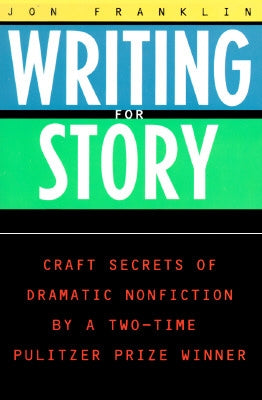1
/
of
1
Plume Books
Writing for Story: Craft Secrets of Dramatic Nonfiction
Writing for Story: Craft Secrets of Dramatic Nonfiction
Regular price
€16,95 EUR
Regular price
Sale price
€16,95 EUR
Shipping calculated at checkout.
Quantity
Couldn't load pickup availability
The new nonfiction--the adaptation of storytelling techniques to journalistic articles in the manner of Truman Capote, Tom Wolfe, and John McPhee--is an innovative genre that has been awarded virtually every Pulitzer Prize for literary journalism since 1979. And now Jon Franklin, himself a two-time Pulitzer Prize winner and undisputed master of the great American nonfiction short story, shares the secrets of his success. Franklin shows how to make factual pieces come alive by applying the literary techniques of complication/resolution, flashback, foreshadowing, and pace. He illustrates his points with a close analysis and annotation of two of his most acclaimed stories, so that the reader can see, step-by-step, just how they were created. This lively, easy-to-follow guid combines readability and excitement with the best of expository prose and illuminates the techniques that beginning journalists--and more experienced ones, too--will find immensely helpful:
Author: Jonathan Franklin
Publisher: Plume Books
Published: 09/01/1994
Pages: 288
Binding Type: Paperback
Weight: 0.55lbs
Size: 7.90h x 5.30w x 0.80d
ISBN: 9780452272958
- Stalking the true short story
- Drafting an effective outline
- Structuring the rough copy
- Polishing like a pro
- and the tips, tools, and techniques that will put your stories on the cutting edge
Author: Jonathan Franklin
Publisher: Plume Books
Published: 09/01/1994
Pages: 288
Binding Type: Paperback
Weight: 0.55lbs
Size: 7.90h x 5.30w x 0.80d
ISBN: 9780452272958
About the Author
Jon Franklin is a well-known pioneer in creative nonfiction. His innovative work in the use of literary techniques in the non-fiction short story, novel, and explanatory essay won him the first Pulitzer Prizes ever awarded in the categories of feature writing (1979) and explanatory jounalism (1985). His books include Writing for Story, The Molecules of the Mind, Guinea Pig Doctors (with J. Sutherland), Not Quite a Miracle (with Alan Doelp), and Shocktrauma (with Alan Doelp). He is a professor at the University of Oregon.
Share


